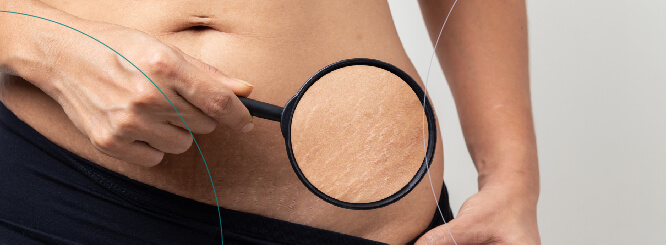
What are stretch marks?
Stretch marks, also known as striae, are benign lesions that appear in the skin, mostly in the abdomen, buttocks, back, breasts, or other parts of the body, after drastic body changes that involve either weight gain or weight loss. Stretch marks are usually thought as something that happens due to pregnancy; however, they can affect any type of people due to many different reasons that compromise skin elasticity. Stretch marks are not really a health issue, since they don’t suppose any risk nor pain for those who have them, but they can be distressing for many people. They are an aesthetic problem that can have an impact on anyone’s self-image and confidence.
How common are they?
Stretch marks affect 50% to 90% of pregnant women [1]. They tend to appear during their mid and final months of pregnancy, and during breastfeeding. Many of these scars tend to subdue and disappear with time, but others can prevail for years. They also appear in 43% of obesity cases [2] where there was rapid weight gain, in some cases of muscle hypertrophy among bodybuilders, in endocrinopathies like the Cushing syndrome, after breast augmentation, as a side effect of topical corticosteroid use and abuse [1], after any kind of surgery, and even after drastic weight loss due to bariatric surgery. Teenagers who experience fast grow and body changes are also prone to developing stretch marks [2].
Which are its causes?
Some scientists link the appearance of stretch marks to hormonal changes, like those that tend to happen during pregnancy and puberty. It is believed that these hormonal changes, in conjunction with physical stretching of the skin, lead to structural alterations of dermal collagen and elastic tissue, which later manifests in noticeable scars.
How can I prevent stretch marks?
There are many recommendations about how to prevent stretch marks. For instance, there are many creams, ointments and cosmetic treatments that promise to prevent, reduce or resolve this issue. These work for some people, but there is a lot of contradicting evidence when testing their effectiveness. In fact, none of these remedies can guarantee to keep people 100% free of any stretch marks.
There are recommendations that may help some people to prevent stretch marks, but these same recommendations might not work for others. So, there is no clear-cut solution for preventing these scars from appearing, but there are some alternatives that favor skin health and that might prevent the emergence of stretch marks.
Take proper care of your skin.
Keeping yourself properly hydrated is vital for having a healthy skin. Drink at least 2 liters of pure water every day. Drinking enough water helps your skin to stay moistened and soft.
Also, make a habit of using a daily moisturizer. Using moisturizer can prevent your skin from drying and itching.
Researchers have found that products containing centella or hyaluronic acid may help prevent stretch marks. Centella is an herb, and our skin naturally contains hyaluronic acid [3].
And finally, remember to use sunscreen daily. Apply enough sunscreen 30 minutes before sun-exposure, and re-apply every 2 hours. Sunscreen protects your skin’s collagen and elastin from the damage of sunrays.
Get enough vitamins, specially C and D.
Keeping a nutrient-rich diet is essential for keeping your body and skin healthy. Vitamin C helps your body produce collagen and it strengthens the elasticity of your skin, preventing wrinkles. Vitamin D also helps to prevent aging and skin decay. Eating plenty of fruits and vegetables can provide the vitamins and minerals your body needs.
Get enough omega-3s
Omega-3 fatty acids can help you regulate your skin’s oil production, prevent skin aging signs, and keep your skin further hydrated.
Control your weight
Keeping a healthy weight reduces your chances of developing stretch marks. You can achieve this by keeping a healthy diet and doing constant exercise every day. Doing exercise at least 30 minutes a day is all it takes.
According to the Centers of Disease Control and Prevention, healthy weight gain during pregnancy depends on initial body weight, as follows:
Weight gain recommendations for pregnant women that are expecting one baby [4]
| Initial body weight | Healthy weight gain |
| Underweight (BMI less than 18.5) | Between 28 and 40 pounds |
| Normal weight (BMI between 18.5 and 24.9) | Between 25 and 35 pounds |
| Overweight (BMI between 25 and 29.9) | Between 15 and 25 pounds |
| Obese (BMI equal to or higher than 30) | Between 11 and 20 pounds |
Keeping your weight inside these ranges can reduce your chances of developing stretch marks, and, if you still get them, they will tend to disappear much faster.
Contact us
At LIMARP International Center of Excellence for obesity, located at Tijuana, Mexico, we offer integral obesity treatments and different cosmetic solutions. If you are interested in knowing more about how to prevent or treat stretch marks, call our clinic. Our team of experts can help.
References
[1] U. Wollina and A. Goldman, “Management of stretch marks (with a focus on striae rubrae),” J. Cutan. Aesthetic Surg., vol. 10, no. 3, pp. 124–129, 2017, doi: 10.4103/JCAS.JCAS_118_17.
[2] A. M. Oakley and B. C. Patel, “Stretch Marks,” in StatPearls, Treasure Island (FL): StatPearls Publishing, 2021. Accessed: Sep. 29, 2021. [Online]. Available: http://www.ncbi.nlm.nih.gov/books/NBK436005/
[3] “Stretch marks: Why they appear and how to get rid of them.” https://www.aad.org/public/cosmetic/scars-stretch-marks/stretch-marks-why-appear (accessed Sep. 29, 2021).
[4] “Weight Gain During Pregnancy | Pregnancy | Maternal and Infant Health | CDC,” May 26, 2021. https://www.cdc.gov/reproductivehealth/maternalinfanthealth/pregnancy-weight-gain.htm (accessed Sep. 29, 2021).


